Tattoo Guns: Essential Tools for Ink Artists
Tattoo guns, also known as tattoo machines, are key tools for tattoo artists. They help create permanent body art. These devices are vital for applying ink and making various designs.
Whether you’re experienced or new to tattooing, knowing about tattoo guns is crucial. It’s important to understand the different types, their parts, and how to pick the right one for you.
Tattoo guns vary in shape, size, and design. Each type is made for different tattooing styles and techniques. From coil machines to rotary guns, the choice affects your work’s quality.
Learning about tattoo gun mechanisms helps you appreciate these tools. They bring your artistic ideas to life.
Table of Contents
What Are Tattoo Guns?
Tattoo guns, also known as tattoo machines, are key tools for tattoo artists. They come in two main types: coil tattoo machines and rotary tattoo machines. Knowing how these machines work is important for choosing the right one for your tattoo needs.
Types of Tattoo Machines
Coil tattoo guns use an electromagnetic coil to move the needle. This gives a steady, reliable performance for lines and shading. In contrast, rotary tattoo machines have a small motor for needle movement. They offer more flexibility and detail for intricate designs and color work.
Understanding Tattoo Gun Mechanisms
The basic mechanism of tattoo machines is simple yet effective. When the artist turns on the machine, the needle goes up and down quickly. This action injects ink into the skin, allowing for detailed, lasting designs.
“The tattoo machine is an extension of the artist’s hand, allowing them to translate their vision into a permanent work of art on the canvas of the human body.”
Whether you like the traditional coil or the newer rotary machines, knowing how they work is crucial. Learning to use these tools well is the first step to creating beautiful, high-quality tattoos.
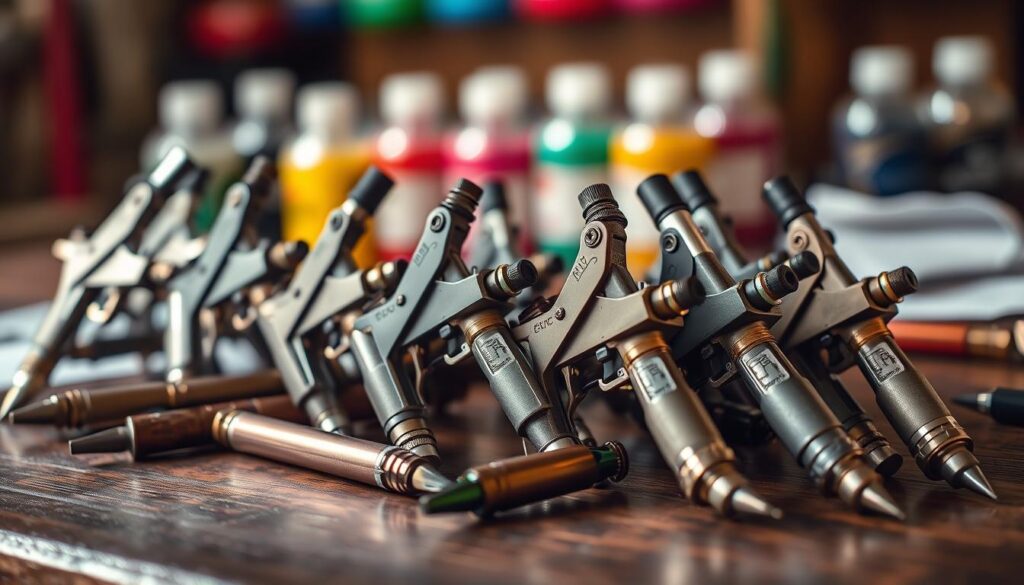
Choosing the Right Tattoo Gun
Choosing between a coil tattoo machine and a rotary tattoo machine is key in tattooing. Knowing what each tattoo gun offers helps pick the best one for your style and vision.
Coil vs. Rotary Tattoo Machines
Coil tattoo machines are great for bold lines and shading. Their electromagnetic coils ensure a steady tattoo experience. This leads to striking, bold results.
Rotary tattoo machines are better for detailed work. They have a smooth needle motion, perfect for fine, intricate designs. The rotary motor offers a soft, precise touch.
“Choosing the right tattoo gun is crucial for achieving your desired results. Understanding the strengths and weaknesses of each type will help you select the tool that best suits your artistic vision.”
Whether you like the power of a coil tattoo machine or the finesse of a rotary tattoo machine, picking the right tattoo gun matters. Knowing each type’s unique features helps you choose the best for your style. This way, you can create stunning, captivating designs.
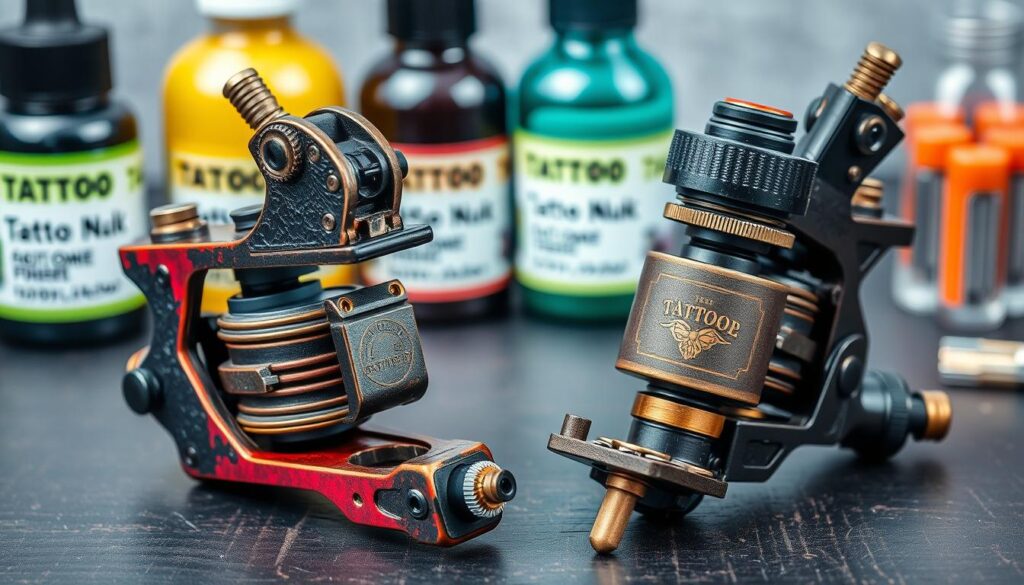
Essential Tattoo Gun Components
There are many important parts to a tattoo setup, besides the tattoo gun. Knowing how each part works is key to making great tattoos.
Tattoo Needles and Needle Configurations
Tattoo needles come in many types, each for a special job. You can find single-needle liners or complex setups for shading and coloring. Picking the right needles is crucial for the tattoo’s look.
- Single-needle liners for crisp, defined lines
- Shader needles for smooth, seamless shading
- Groupings of needles for bold, saturated color application
Tattoo Ink and Ink Cups
Tattoo ink is used by the tattoo gun to create the design on the skin. The ink’s quality and how it works with the skin are very important. Choosing the right tattoo ink and tattoo ink cups is key for a good tattoo.
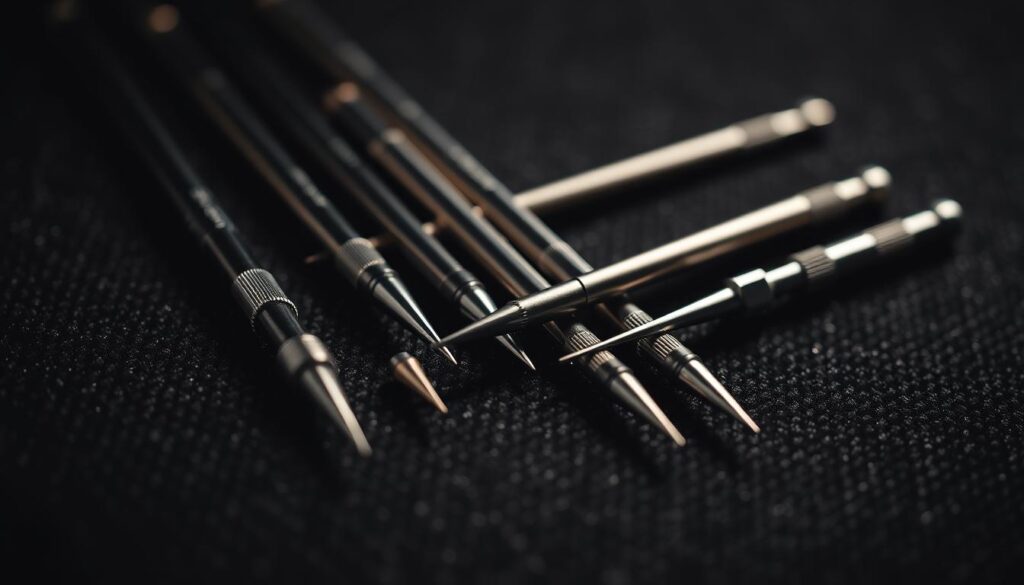
“Mastering the essential components of a tattoo setup is the foundation for creating outstanding, long-lasting ink art.”
Tattoo Power Supplies
A reliable tattoo power supply is key for tattoo artists. These units make sure your tattoo gun works well and safely. They give the right current and voltage for the machine’s motor or coils.
Tattoo power supplies turn regular household electricity into the power your tattoo machine needs. They control the electricity flow. This prevents issues like uneven needle depth or too much heat.
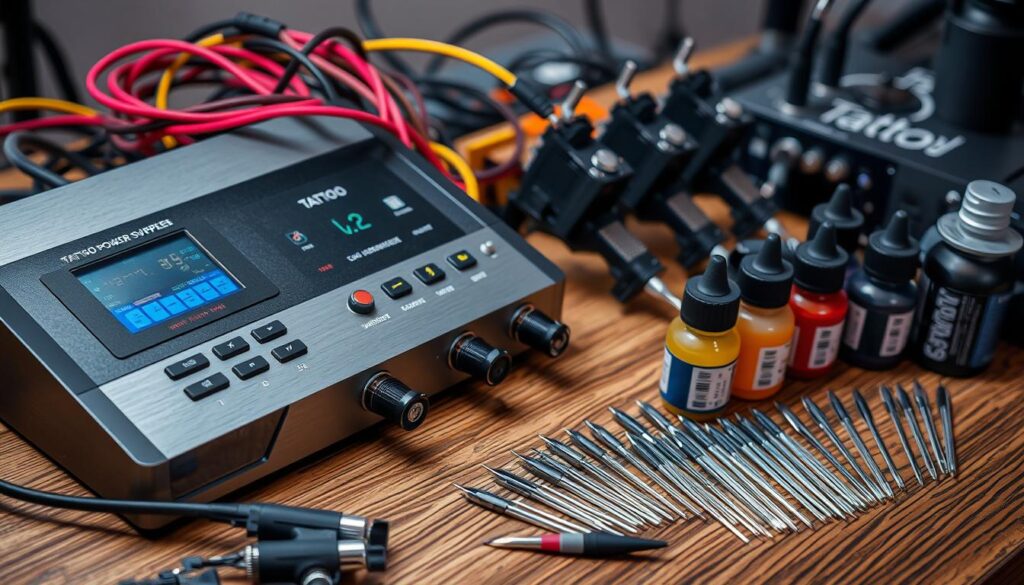
When picking a tattoo power supply, look at adjustable voltage and amperage, digital displays, and safety features like overload protection. These features let you adjust the power for your tattooing needs. This ensures your tattoo gun works smoothly and consistently.
Getting a top-notch tattoo power supply can really improve your tattooing. It gives you a stable power source. This helps you do your best work and keeps a safe environment for you and your clients.
Tattoo Grips and Tube Attachments
As a tattoo artist, the grip and tube attachment of your tattoo gun are key. They affect your comfort and control during tattooing. The right tattoo grips and tube attachments can greatly improve your efficiency and reduce fatigue, especially during long sessions.
Ergonomics and Grip Styles
Tattoo grips come in many shapes and sizes, fitting different hand sizes and preferences. The grip you choose can greatly affect your control and comfort. Here are some popular grip styles:
- Pencil Grip: Offers a natural, intuitive feel, similar to holding a pen or pencil.
- Finger Grip: Provides a secure, three-finger hold for enhanced precision and control.
- Palm Grip: Allows for a more relaxed, palm-supported hold, reducing hand strain.
The tube attachment, which connects your tattoo gun to the ink supply, is also important. Its weight, balance, and compatibility can greatly impact your ability to maneuver the tattoo gun with ease and accuracy.
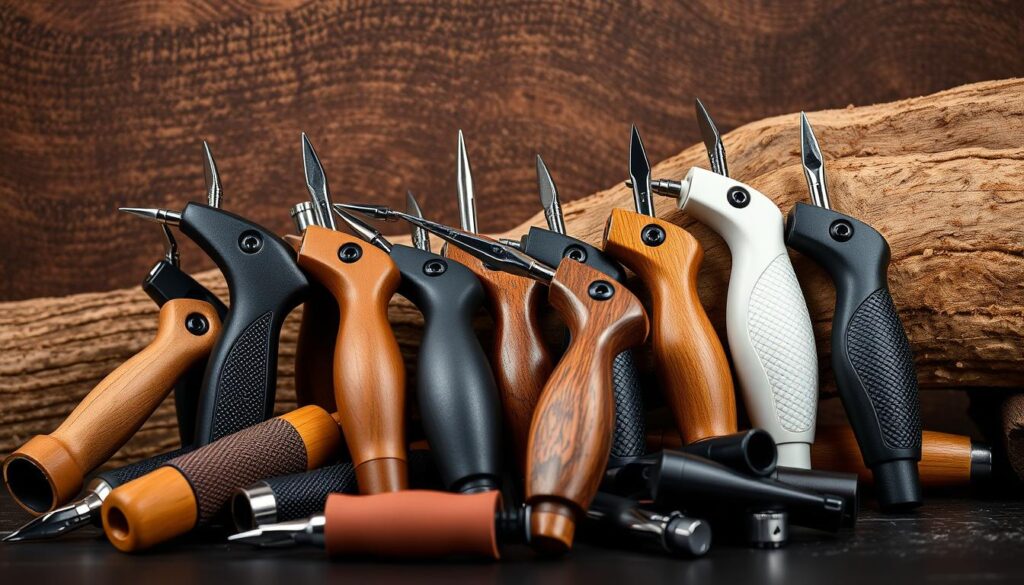
Try out different tattoo grips and tube attachments to find the best fit for you. Finding the right ergonomic setup can significantly improve your tattooing experience and the quality of your work.
Tattoo Stencils and Transfer Papers
As a tattoo artist, you know how key precision is. Tattoo stencils and transfer papers are vital for this. They help you map out designs and transfer them to the skin with great accuracy.
Tattoo stencils act as a guide for your design. They ensure the tattoo’s outline and placement are spot on. This way, you can avoid mistakes and create a clean, professional tattoo. Stencils come in many shapes and sizes, meeting each client’s unique needs.
Transfer papers, meanwhile, help move the design from the stencil to the skin. This step is vital for getting the tattoo’s position and proportions right. With transfer papers, you can see the final tattoo before starting, boosting your confidence in your work.
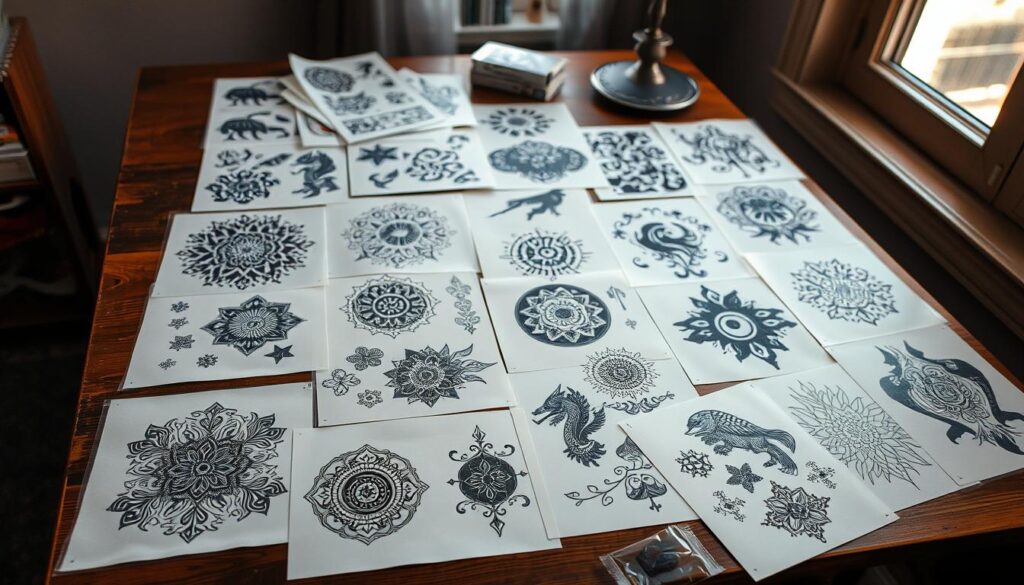
Using these tools can take your tattoo art to the next level. Whether you’re experienced or just starting, mastering tattoo stencils and transfer papers is key. It’s a step towards becoming a true ink master.
“Precision is the key to creating a masterpiece, and tattoo stencils and transfer papers are the tools that help me achieve it.” – Jane Doe, renowned tattoo artist
Tattoo Guns for Beginners
Starting your tattoo art journey is thrilling, but picking the right tattoo gun is key, especially for newbies. Luckily, there are beginner-friendly tattoo gun kits and entry-level options. These help new artists improve their skills before moving to more advanced tools.
Starter Kits and Entry-Level Options
Starter tattoo kits come with everything you need to start, making them great for beginners. These entry-level tattoo guns are easy to use. They have simple designs and features that help new artists practice and get better.
- Tattoo guns for beginners: These machines are simple and easy to use, focusing on simplicity over complex features.
- Starter tattoo kits: These sets have everything you need to begin, including the gun, needles, inks, and more.
- Entry-level tattoo guns: These affordable options are perfect for newbies, offering a good start without costing too much.
“Choosing the right tattoo gun is crucial for beginners. The right entry-level tools can help you build your skills and confidence before moving to more advanced ones.”
By picking the right tattoo guns for beginners, starter tattoo kits, and entry-level tattoo guns, new tattoo artists can start their journey well. They’ll have a solid base and the confidence to grow their skills over time.
Tattoo Gun Maintenance and Care
Keeping your tattoo gun in good shape is key for its long life and your clients’ safety. You need to clean and sterilize it often. This includes the gun itself, its parts, and the area around it. Following strict hygiene rules helps stop infections and makes tattooing safe for everyone.
Cleaning and Sterilization Techniques
To keep your tattoo gun in top shape, follow these essential cleaning and sterilization techniques:
- Disassemble the tattoo gun: Carefully take apart the gun, separating the individual components, such as the grip, tube, and needle holder.
- Clean the components: Thoroughly clean each component using a designated tattoo gun cleaner or a mixture of warm water and mild soap. Scrub away any residual ink or debris.
- Sterilize the components: Place the disassembled components in an autoclave or use a chemical sterilization solution to ensure they are free from any harmful microorganisms.
- Wipe down the work area: Clean and disinfect the work surface, including the tattoo chair, trays, and any other equipment, to maintain a sterile environment.
- Reassemble the tattoo gun: Carefully put the cleaned and sterilized components back together, ensuring a proper and secure fit.
By following these tattoo gun maintenance and tattoo gun cleaning steps, you can make your tattoo gun last longer. This also ensures your clients get a tattoo gun sterilization process that focuses on their safety and health.
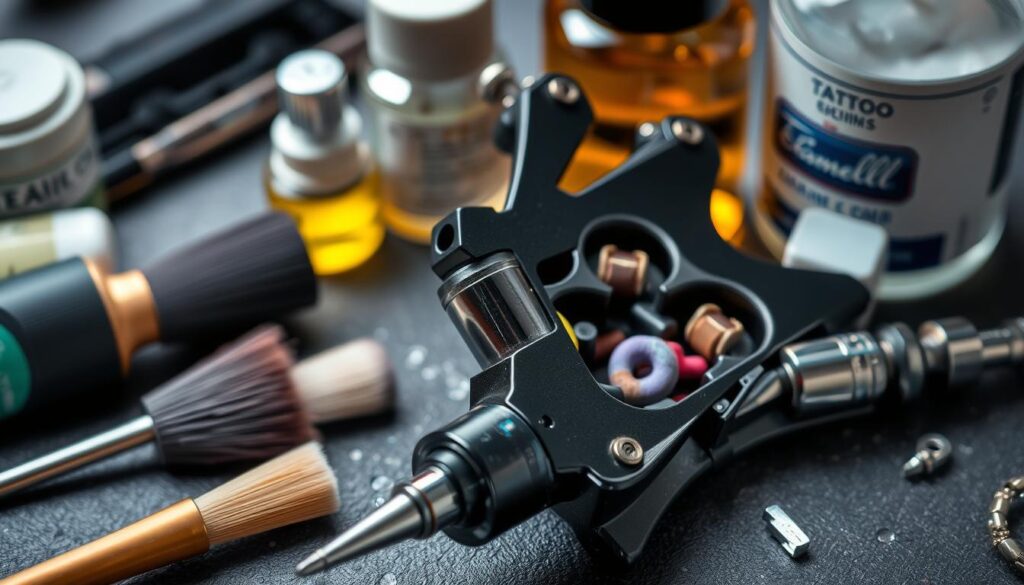
“Proper maintenance and care of your tattoo gun are essential for ensuring the device’s longevity and the safety of your clients.”
Advanced Tattoo Gun Techniques
As you get better at tattoo art, you can try more complex techniques. Learning to line, shade, and pack color with your tattoo gun lets you make amazing body art.
Tattoo Lining: Precision and Perfection
Lining is key for making clean, sharp outlines. It needs a good grasp of needles, machine settings, and how to use ink. Getting good at lining is crucial for starting any tattoo design.
Shading: Bringing Depth and Dimension
Shading fills in areas with different colors, adding depth to your tattoos. By adjusting your tattoo gun and needle, you can get smooth shading. This makes your artwork look even better.
Color Packing: Vibrant and Lasting Ink
Color packing means packing color tightly into the skin for lasting vibrancy. It takes a fine touch and knowing how needles and ink work together. This skill is essential for keeping tattoos looking bright.
Being great at tattoo gun techniques like tattoo lining, tattoo shading, and tattoo color packing shows you’re a top tattoo artist. Keep practicing and experimenting with your tattoo gun. This way, you can make stunning body art that wows your clients.
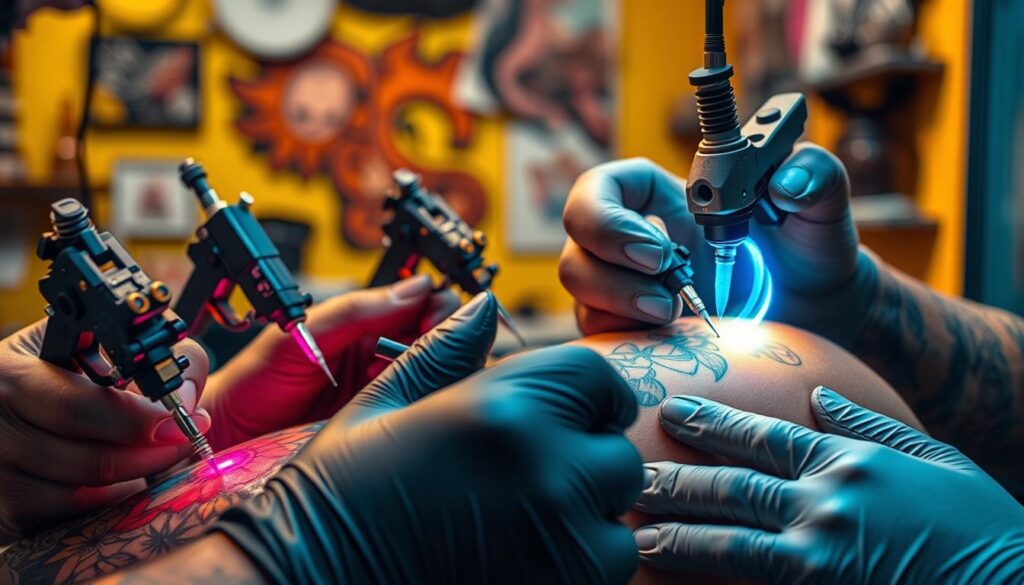
Tattoo Gun Safety Considerations
Working with tattoo guns requires keeping both the artist and client safe. Tattoo artists must focus on sterilization, use single-use needles, and follow strict infection control. This ensures a safe and enjoyable experience for everyone.
Proper sterilization is key to tattoo gun safety. Clean and disinfect your equipment before each use to avoid infections. This includes the tattoo gun, needles, and any tools or surfaces touching the client’s skin.
- Use an autoclave or approved methods to sterilize equipment.
- Dispose of used needles in a sharps container to prevent injury or contamination.
- Keep your workspace clean and organized to reduce infection or accident risks.
Ergonomics is also crucial for tattoo gun safety. Tattoo artists can get injuries like carpal tunnel or tendinitis from repetitive tasks. Use proper techniques and take breaks to rest your hands and arms.
“Taking care of your body is just as important as taking care of your equipment. Prioritize ergonomics and self-care to ensure a long and healthy career as a tattoo artist.”
By focusing on tattoo gun safety, tattoo safety, and tattoo equipment safety, you can create a safe and efficient work environment. Always put safety first when using tattoo guns.
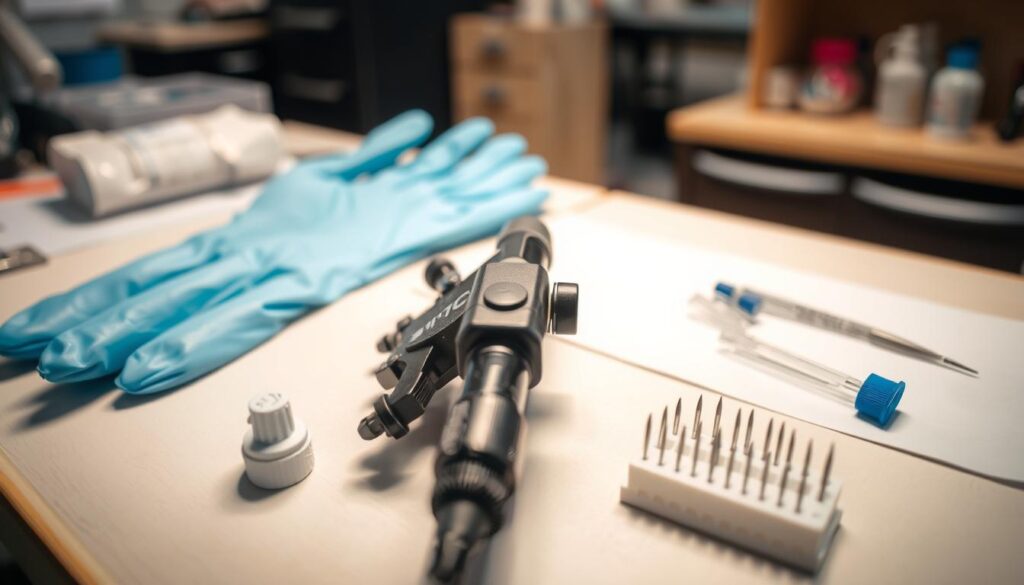
Tattoo Gun Trends and Innovations
The tattoo gun world is always changing. New tech and designs keep popping up. As an artist, knowing the latest tattoo gun trends helps you offer top-notch tattoos to your clients.
Recently, there’s been a big leap with lightweight, ergonomic tattoo guns. These machines are not only comfy but also boost precision and control. This means you can do more detailed work. Plus, some new tattoo technologies let you adjust settings like needle depth and power. This gives you more control over your work.
- Lightweight, ergonomic tattoo gun designs for improved comfort and control
- Programmable tattoo guns with adjustable settings for personalized tattooing
- Innovative needle configurations and ink delivery systems for enhanced precision
It’s key for tattoo artists to keep up with tattoo gun trends and new tech. By using these advancements, you can improve your skills and give your clients a better tattoo experience. This will make them want to come back for more.
“The constant evolution of tattoo gun technology has transformed the industry, allowing us to push the boundaries of what’s possible with ink and skin.”
Conclusion
Tattoo guns are key tools for artists to create on human skin. Knowing about different machines, their parts, and how to use them is important. This knowledge helps you choose the right tools and give great tattoo experiences.
Whether you’re experienced or new, learning about tattoo guns is crucial. It’s a step to becoming a respected and successful tattoo artist.
The tattoo world has many options, from coil to rotary machines. There are also essential needles, inks, grips, and power supplies. By keeping up with trends and focusing on safety and maintenance, you can improve your skills.
With the tattoo gun, you can master lining, shading, and color packing. It lets you bring your artistic vision to life. By understanding and improving your skills, you’ll become a trusted tattoo artist in the body art world.







